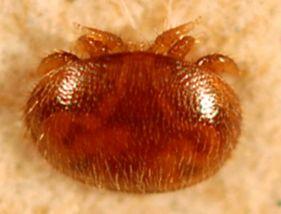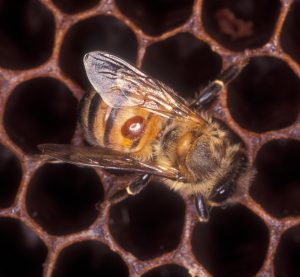Varroa destructor

Background: Varroa is the most devastating pest of the western honey bee. It is responsible for the death of honey bee colonies world-wide, resulting in millions of dollars of damages. The mites are thought to feed on the honey bee hemolymph, and thus, effectively vector a wide variety of viruses. The mites reproduce in the honey bee brood cells. They enter into a worker or drone cell (Varroa prefer drone brood) just before it is capped, feed on the honey bee brood, and lays eggs. By the time the honey bee has developed and emerges from the cell, the mature, mated female mites emerge with the bee and continue to feed on the bee until the next opportunity to enter a cell and continue their reproductive cycle.
Symptoms: Honey bee colonies infested with Varroa often demonstrate symptoms that are easy to recognize. If you notice nurse bees with deformed wings, a spotty brood pattern, a reduced colony population, unexpected queen supersedure, and perforated capped cells, you likely have a mite infestation.

Monitoring: The most obvious way to detect the presence of Varroa within a colony is to look for the mites in the correct places. Look for mites in capped drone brood cells, the debris on a bottom board, and of course, on the bodies of the adult workers. It is important to monitor the mite levels in your colonies frequently, so you can treat for the mites before they reach levels that threaten colony productivity and survival. The most common way to quantify your Varroa levels is by collecting a sample of 300 bees (about half-cup) and using a powdered sugar shake or an alcohol wash to separate the mites from the bees. The ratio of mites that you find per bee will helpyou determine if you have a problem. Many beekeepers feel that if their colonies cross the threshold of 3-5 mites per 100 bees, there is an urgent need to treat.

Treatment: The timing of Varroa control treatment is greatly dependent upon your goals as a beekeeper. Generally, treating your colonies in the early spring, a couple months before you start adding honey supers will help keep the mite populations low while your colony grows. It is also common to treat in the fall after the honey supers have been removed to reduce the number of mites before winter.
For more information on Varroa, check out this Video Field Guide to Beekeeping with Dr. Jamie Ellis or read this EDIS document.
“Pest Profile” will be a reoccuring feature on the UF HBREL Blog. Check back soon for more info on various honey bee pests.
Do you have something to say? Join the discussion on our Facebook Page (https://www.facebook.com/UFHoneyBeeLab/).
 0
0
